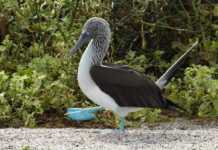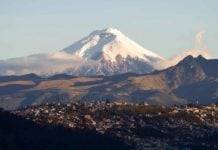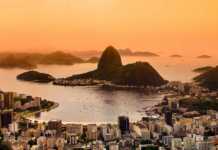Ecuador in South America is named after the equator which runs directly through the country. It is a land filled with incredible volcanoes, towering mountains and mystical cloud forests. Famous for the Galápagos Islands, the highest capital city in the world, Quito, and Mount Chimborazo whose peak is the closest point on earth to the sun, Ecuador is one of the best countries to visit in South America. From historic markets to fortresses to Incan ruins, there are many historical, natural and famous landmarks in Ecuador to explore. Here are 20 that you must not miss.
20 Ecuador Landmarks
Famous Landmarks in Ecuador
1- Galapagos Islands
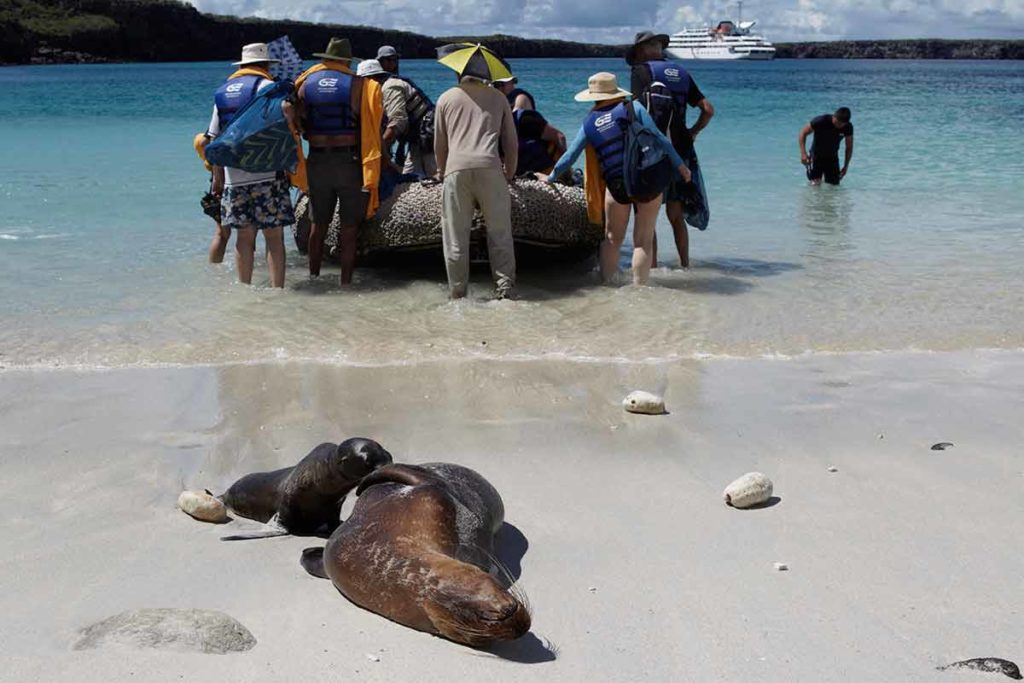
While not part of mainland Ecuador, the Galápagos Islands are one of the most famous places to visit.
The islands are often called the ‘Enchanted Isles’ and sit 960 km (600 miles) off the coast of Ecuador.
Much of the land is a national park which was established in the 1960s to protect the landscape and its ecosystems.
The waters surrounding the islands have also been declared a UNESCO Biosphere Reserve, extending the protection of the island to its marine life making Galapagos Islands famous for its animals.
Head to Isabela, where you can catch a glimpse of the Galapagos penguin, the second smallest species of penguin in the world and the only species of penguin to be found on the Northern Hemisphere and other native birds.
Isabela Island is also home to Muro de las Lagrimas (Wall of Tears), stone wall, built between 1946 and 1959, was constructed by prisoners in a penal colony under harsh and inhumane conditions.
San Cristobal Island, one of the oldest in the Galapagos archipelago, is known for its rich biodiversity, stunning beaches, and being home to the iconic Galápagos sea lions and the historic site of Kicker Rock.
Galapagos sea lions are playful and social marine mammals found lounging on beaches or gracefully swimming in the waters around the Galápagos Islands, where they are a symbol of the archipelago’s unique wildlife.
2- Ingapirca Ruins
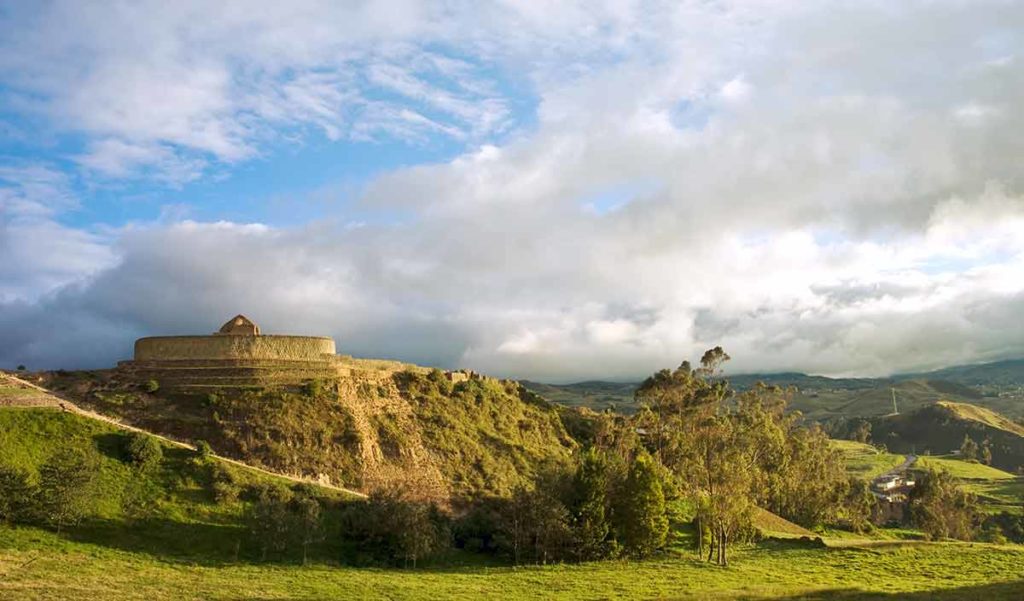
Translating to ‘Inca Wall’ in Kichwa, Ingapirca Ruins is an amazing landmark in Ecuador and an icon of a past culture.
The ruins are pre-Columbian and mark the site of a Cañari settlement.
Much of the site is simply stone foundations today, so take a guided tour to learn more about the lives of the Cañari people.
Temple of the Sun in Ingapirca Ruins is the only one of its kind in the entire Incan empire.
The temple is elliptical and was built atop a ceremonial rock.
Archaeologists believe that the temple was also a site for rituals, as well as being used to chart when important festivals would occur.
3- Mitad del Mundo

The Mitad del Mundo in Quito marks the middle of the world, with the city located in two hemispheres.
In 1736, French explorers determined that the equatorial line at the site where the monument now stands was the middle of the world, so you can stand with one foot in each half of the world.
A painted line running along the ground represents the calculated line.
Sadly for the French explorers, the true equator lies 240 m (787 feet) north of his initial calculations, however, in Quito the monument marks an intriguing part of the cities history.
The Itiñan Solar Museum nearby in San Antonio de Pichincha, just outside Quito, is an interactive museum lies with fascinating exhibits on the science, culture and history of the region, including experiments demonstrating equatorial physics, such as balancing an egg on a nail.
It’s a popular destination for those exploring Ecuador’s rich heritage and the wonders of the equator.
4- Catedral Nueva
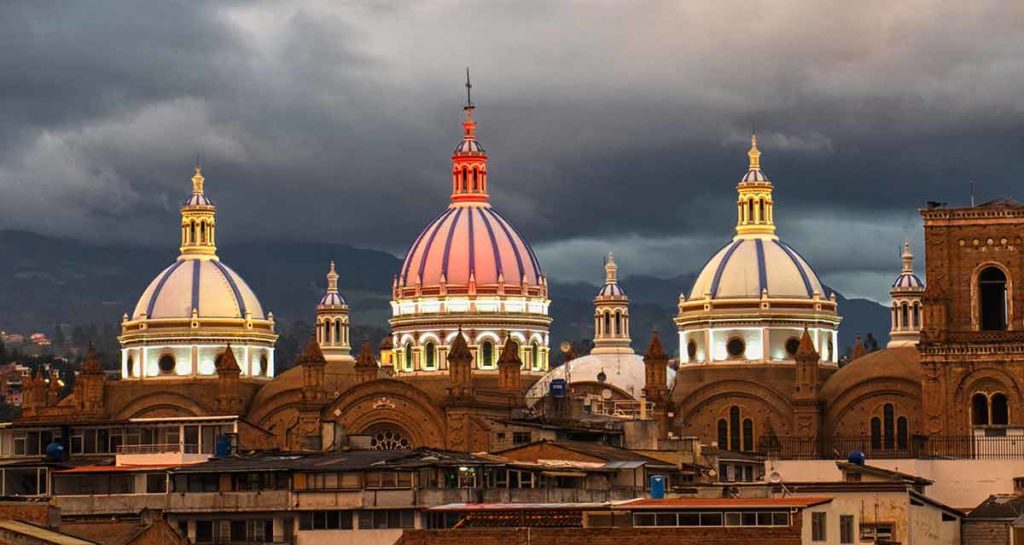
Catedral Nueva dates back to the 19th century, and unlike many other catholic churches in South America, it remains unfinished.
The cathedral is designed in Roman, Gothic, Baroque and Renaissance styles.
Within the church is a stunning Baroque altar, which is designed to be a replica of an altar in St Peter’s in Rome.
The pink marble exterior is elaborately decorated with stained glass windows, turrets and crosses, and its white and blue domes.
The six domes are adorned by blue glazed tiles which were imported from Czechoslovakia.
The cathedral was built in 1885 to replace an old cathedral, and to accommodate the growing population of Cuenca.
5- Otavalo Market
Volcanic peaks encircle the town of Otavalo, in Imbabura Province, known as the “Land of Lakes” for its stunning highland scenery featuring volcanic peaks, picturesque lagoons and rich cultural heritage.
A must-visit place is the Otavalo market which has enabled the local economy to thrive.
The market predominately consists of textiles and crafts made by the indigenous people of the area.
Saturdays is when the local people in the market take over a third of the town with brightly coloured fabrics, paja toquilla hats, ponchos wall hangings and beads.
6- Virgen de El Panecillo
The Virgen de El Panecillo, a statue of the Virgin Mary with wings and a halo of stars, is the world’s tallest aluminium statue.
The statue is on a hill in the centre of Quito and was erected in the 1970s, following nearly 20 years of debate and discussion.
The statue is a replica of another Ecuadorian statue of the Virgin of Quito, a 30 cm (12-inch) wooden statue made by Bernardo de Legarda in 1734.
Virgen de El Panecillo was designed and made by Spanish sculptor Agustin de la Herran Matorras, who created his replica in 7400 pieces of aluminium, stretching to 98 meters tall.
7- Nariz del Diablo
El Nariz del Diablo, or the Devils Nose, forms part of the ‘most difficult railway in the world’.
The railway runs from Guayaquil on the coast to Quito in its highlands.
El Nariz del Diablo is a near-vertical wall of rock, which posed a significant challenge during the railway’s construction in 1899.
To climb the 800-meter wall, which has a steep gradient of 1-in-18, the engineers designed the track to zigzag up the wall.
At present, due to damage caused by El Nino, only a 12 km (7.5 miles) stretch of the railway is currently open.
However, it is undergoing restoration work spanning the entire stretch to ensure that passengers can experience the full journey once more.
Also read:
- 20 USA Landmarks
- 23 Canada Landmarks
- 22 Ohio Landmarks
- 21 Arizona Landmarks
- 21 Minnesota Landmarks
- 21 Oregon Landmarks
- 21 Illinois Landmarks
- 21 Colorado Landmarks
- 21 Georgia Landmarks
- 21 Michigan Landmarks
- 23 Los Angeles Landmarks
- 21 Washington Landmarks
- 21 Maryland Landmarks
- 20 Manitoba Landmarks
- 20 Kansas Landmarks
- 21 New Mexico Landmarks
- 20 Idaho Landmarks
- 20 Montana Landmarks
- 20 Oklahoma Landmarks
- 21 Wisconsin Landmarks
- 20 Tennessee Landmarks
- 20 Alabama Landmarks
- 21 Iowa Landmarks
- 20 Alaska Landmarks
- 20 Miami Landmarks
- 21 West Virginia Landmarks
- 21 Kentucky Landmarks
- 20 Louisiana Landmarks
- 21 Arkansas Landmarks
- 20 Cincinnati Landmarks
- 20 San Antonio Landmarks
- 20 Wyoming Landmarks
- 25 Indiana Landmarks
- 21 New York Landmarks
- 28 Texas Landmarks
- 23 Boston Landmarks
- 29 Florida Landmarks
- 26 Hawaii Landmarks
- 15 South Dakota Landmarks
- 21 Pennsylvania Landmarks
- 23 New Jersey Landmarks
- 20 New Hampshire Landmarks
- 21 Virginia Landmarks
- 21 North Carolina Landmarks
- 21 Utah Landmarks
- 21 Nevada Landmarks
- 20 Massachusetts Landmarks
- 22 Washington DC Landmarks
- 20 Vermont Landmarks
- 20 Nebraska Landmarks
- 21 North Dakota Landmarks
- 21 Missouri Landmarks
- 20 Rhode Island Landmarks
- 21 Maine Landmarks
- 21 Connecticut Landmarks
- 20 San Diego Landmarks
- 20 Landmarks In South Carolina
- 20 Mississippi Landmarks
- 20 Las Vegas Landmarks
- 22 Dallas Landmarks
- 20 Houston Landmarks
- 20 Seattle Landmarks
- 20 Landmarks In Puerto Rico
Natural Landmarks
8- Leon Dormido
Kicker Rock (known locally as León Dormido, or “Sleeping Lion”) is a striking volcanic formation off the coast of San Cristóbal Island and a towering rock, split into two massive vertical slabs, that rises dramatically out of the ocean and is a popular destination for snorkeling and diving.
The waters around Kicker Rock are teeming with marine life, including sharks, sea turtles, white-tipped reef sharks and colourful fish, making it a must-visit spot for nature enthusiasts and adventurers.
Named Leon Dormido for its resemblance to a sleeping lion, this rock formation is a spectacular natural monument to visit when in Ecuador.
The ancient rock’s narrow gap is just big enough for a small sailboat to pass through.
Leon Dormido is not accessible due to its sheer faces but you can go on a boat, snorkelling and scuba-diving expedition in the area.
Boat trips depart from Puerto Baquerioz Moreno and it takes an hour to reach. Visit at sunset for particularly spectacular views.
9- Cueva de Los Tayos
An extraordinary natural attraction in Ecuador is the Cueva de Los Tayos.
For hundreds of years, the cave was only used by the indigenous Shuar people.
However, an expedition to the cave in 1976 revealed extraordinary findings, including rare and unusual zoological and botanical species.
The cave is in the centre of dense jungle in the eastern foothills of the Andes.
The Shuar people descend into the cave on ladders made from vines through one of three entrances.
At its deepest, the cave is 213 feet deep and leads to numerous tunnels and chambers.
The largest chamber in the system is 295 feet by 787 feet.
10- Puyango Petrified Forest
Puyango Petrified Forest is the largest petrified forest in South America.
The forest is 100 kilometres from Machala and stretches across the semi-arid river valley on the Peruvian border.
Dozens of fossilized tree trunks from 120 million years ago are preserved here.
Amongst the enormous fossilised remains are many araucaria trees which used to grow in the area.
The trunks are mostly fragmented however a few whole trees remain, reaching 1.6 meters in diameter, and 11 meters tall.
Within the forest remains of ancient ferns which can be pointed out by local guides.
A museum near the visitor centre is filled with marine fossils from when the area was covered by the sea, fossilised fruits, octopus and tortoises.
11- Cloud Forest
Almost every country in South America has a cloud forest, a naturally occurring phenomenon at certain altitudes, however, none are quite as beautiful as Ecuador’s.
The forest is near Quito and is filled with lush vegetation, moss and vine-covered trees, and spectacular wildlife.
As the cloud forest is at altitude and in a mountainous region, views over the surrounding area from between the trees are spectacular; mist rolling across the mountains with the jungle breaking through the surface of the clouds.
Many species of orchid can be found within the cloud forest, as well as rare birds such as the Jocotoco Antpitta bird which was discovered in 1997.
12- Cotopaxi
Located within the Cotopaxi National Park, close to the capital city, is Ecuador’s second tallest active volcano – Cotopaxi.
Cotopaxi can be seen from many locations across the capital, with many residents seeing it as a guardian standing over the city.
The volcano is favoured amongst mountain climbers for its challenge, imperfect conical shape and beautiful views over the city, mountain range and cloud forests.
Based on volcanology records, Cotopaxi has erupted more than 50 times since 1738, and as a result, has created many valleys surrounding the volcano as the lava cools and hardens.
13- The Hot Springs of Banos
Banos Hot Springs is a spectacular natural attraction to visit.
The town of Banos is nestled between lush mountains and waterfalls and gets its name from the hydrothermal springs in the area.
Within the area, three are over 10 waterfalls, one of which is immediately next to the hot springs.
The nearby Tungurahua Volcano heats the water in the springs. Start in one of the higher pools for water with pleasant temperatures, before braving the much hotter pools lower down.
La Casa del Arbol (The Treehouse) has stunning views of the active Tungurahua Volcano. Perched high on a hillside, La Casa del Arbol serves as a seismic monitoring station but has gained fame for its “Swing at the End of the World.”
This simple yet exhilarating swing lets visitors soar over a steep drop, offering an unforgettable adrenaline rush paired with breathtaking panoramas of the lush Andean landscape.
14- Laguna Quilotoa
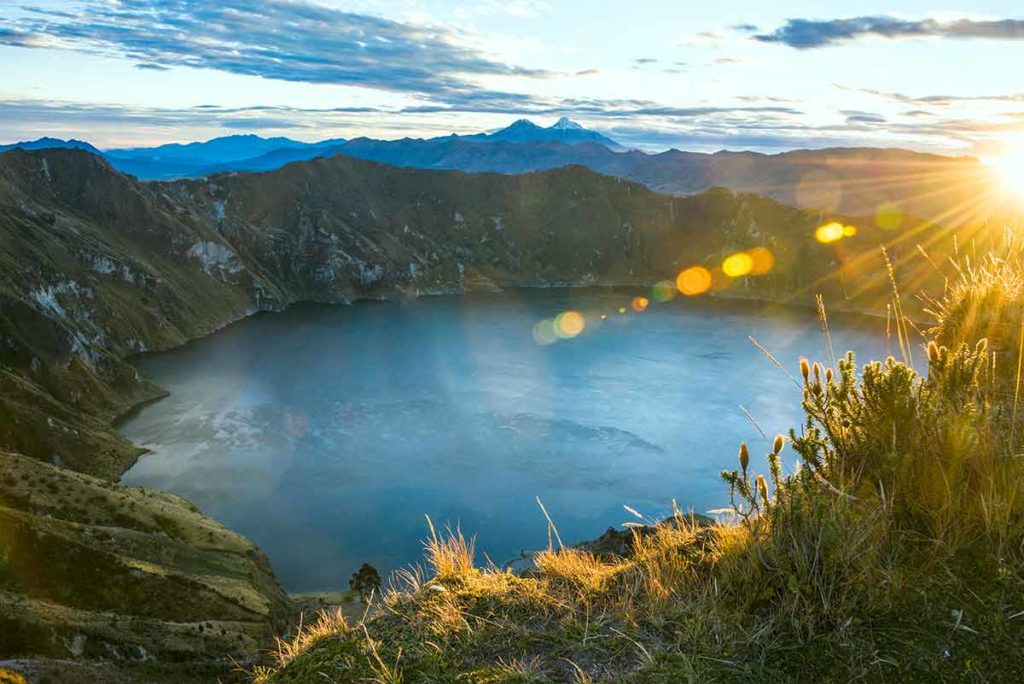
Laguna Quilotoa is a water-filled volcanic crater in the Ecuadorian highlands.
The water sits 400m below the edge of the crater and is an incredible shade of turquoise due to the minerals in its waters.
Geologists believe that the crater and lake are 250 meters deep, although locals believe it has no bottom.
For the best lake views, hike along the rim of the crater.
The hike is 7.5 km (4.6 miles) and offers spectacular views not only of the lake but of the Andes surrounding it too.
Historic Landmarks
15- La Compania de Jesus
Ornate in every sense, La Compania de Jesus in Quito is a spectacular historical building.
The church is adorned with green and gold domes and a lavishly carved interior.
The walls inside are painted bright red as a reminder of the blood of Christ and a large part of the interior is covered in gold leaf.
Among the religious carvings are examples of native Ecuadorian plants and indigenous peoples.
It’s filled with paintings and sculptures by artists, featuring bible stories and religious references, as well as saints and prophets.
It took 160 years to complete what is considered to be one of the finest Spanish Baroque pieces of architecture in South America.
16- San Francisco Church
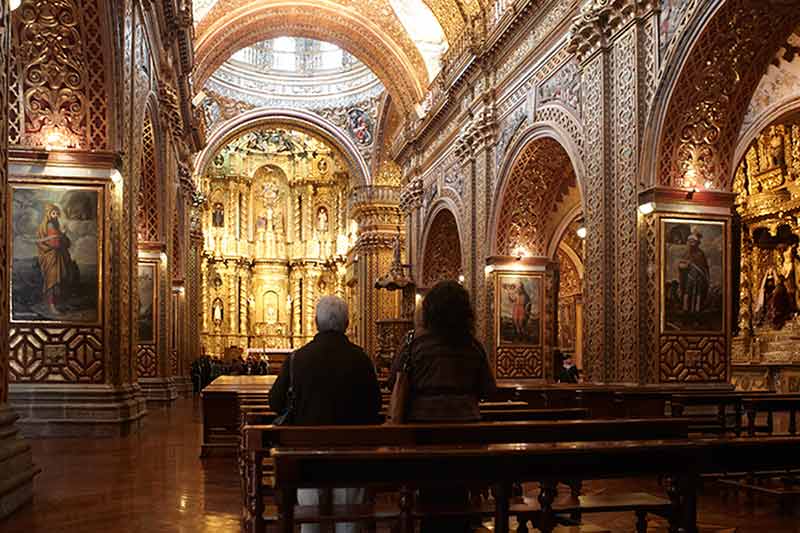
A church and monastery in Quito’s Old Town, San Francisco is an amazing landmark to visit.
The building dates from the 16th century and features a temple, chapels and convent.
A homage to Ecuador’s Incan history is noticeable as you enter the church; traditional Incan representations for the sun are placed carefully as a way of attracting indigenous people religion.
This blend of Incan and Catholic iconography is evident throughout through the carvings and artwork.
The church features Moorish styling on its ceiling, Baroque detailing in the chapels, a golden high altar and 3500 pieces of art.
17- Pambamarca Fortresses
Consisting of a large number of pukaras, or hilltop forts, Pambamarca was a vital stronghold for the Incas during the 15th century.
The fortress was constructed in the 15th century atop an eroded volcano.
They were designed to mark the boundaries of the Incan empire and were the hosts of bloody and violent battles throughout the 15th and 16th centuries.
The structures are predominately well preserved and were made from individual bricks.
The largest complex at Pambamarca is made up of more than 70 stone structures.
18- Yaku Waa
A lesser-visited historical landmark is Yaku Waa, a cave system near Charupe.
There are many legends associated with the caves in Ecuador and Yaku Waa.
It was long believed that the cave was home to an immense library, however, this legend was later linked to the Cueva de Los Tayos.
Hiking to Yaku Waa with a local guide is recommended, not only to ensure your visit is safe but also to learn more about the local legends associated with the cave.
19- La Tolita
La Tolita is an island famed for its archaeological significance and home to a ceremonial site built by the island’s inhabitants centuries ago.
At the site, archaeologists have found pottery, gold and other offerings that would have been used in ceremonies.
Findings on the island also indicate that its inhabitants would have worked with silver and platinum.
Many important historical artefacts have been found on the island and are now displayed at the site.
20- Basilica del Voto Nacional
The Basilica del Voto Nacional, or Basilica of the National Vow, is a Roman Catholic cathedral in Quito.
The cathedral is the largest example of neo-Gothic architecture in South America.
Building began on the cathedral in 1892. Unlike traditional Catholic churches, with gargoyles adorning the façade, the basilica is decorated with turtles and iguanas.
The cathedral remains partially unfinished, and local legend tells that the world will end if construction on the basilica is ever finished.
Climb the churches 377 foot high towers for spectacular views.
For more about Ecuador, read:
- 20 Beaches in Ecuador
- 20 Landmarks in Ecuador
- Animals of the Galapagos Islands
- Galapagos Islands Itinerary
- 15 Things To Do In Quito
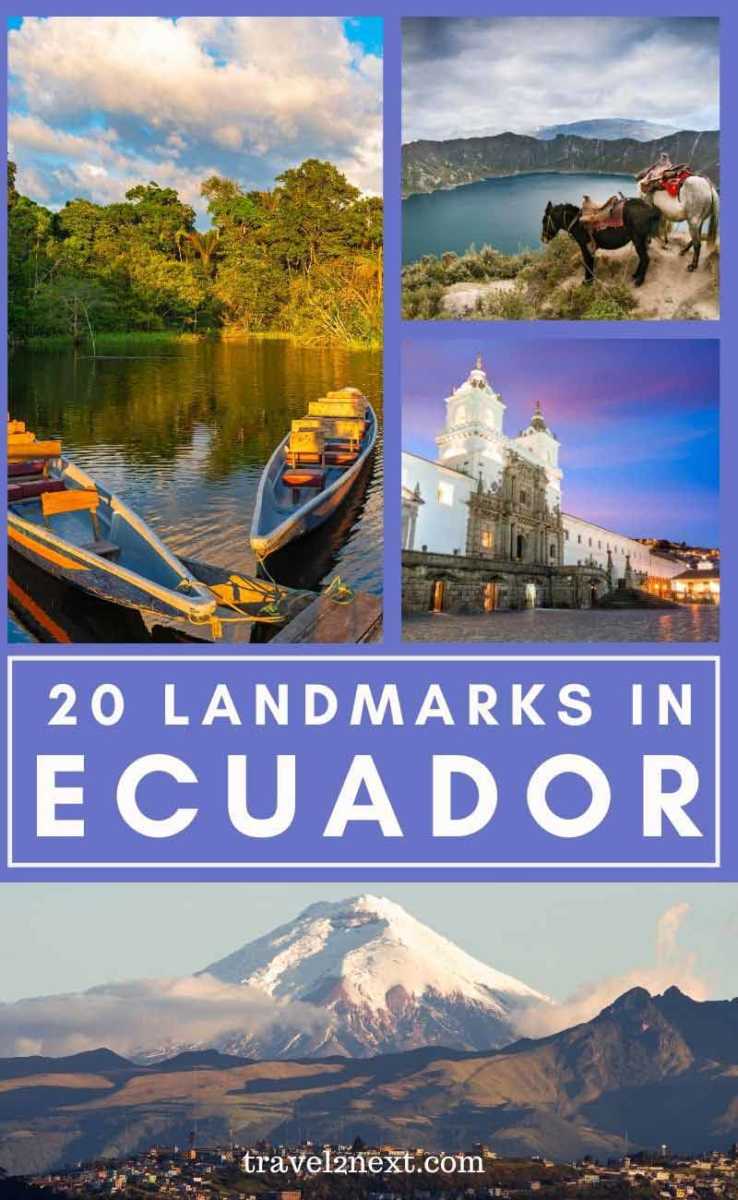
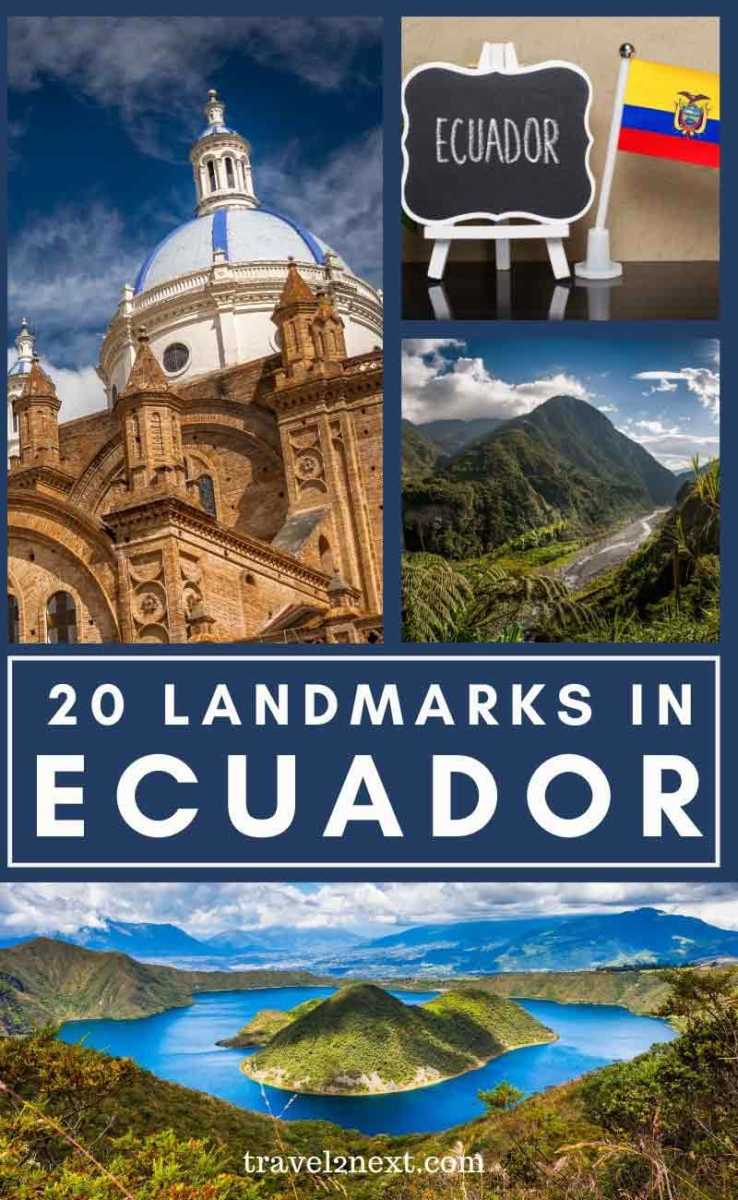
Plan Your Trip

Rent A Car – Find the best car rental rates at Discover Cars. They compare car hire companies to provide you with the best deal right now.

Find A Hotel – If you’re curious about this article and are looking for somewhere to stay, take a look at these amazing hotels.
